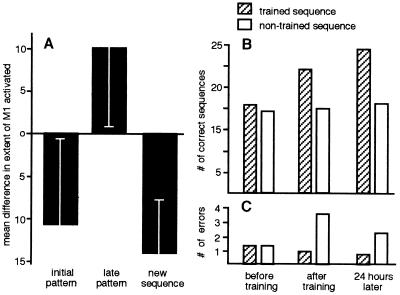Figure 3.
Cortical and behavioral effects of short-term practice. (A) Cortical effects. The ordering effects during the initial imaging session: The mean difference in the extent of the evoked signal calculated as the difference in the number of pixels in M1 in which the signal changed above a threshold of Z = 2 during the respective activation intervals relative to rest, for each set (X2-X1, see text) during the two activation intervals of the initial and late sets of the session as well as when a new sequence was introduced is shown. Initial pattern: Averaged data from five subjects from the first two sets of each subject showing the initial ordering effect irrespective of sequence type, lesser extent of M1 activated during the second compared with the first interval. Late pattern: Averaged data from the two late sets in the session (sets 6 and 7) of five subjects showing the reversed ordering effect, irrespective of sequence type, larger extent of M1 activated during the second compared with the first interval. New sequence: Averaged data from three subjects (one set each) performing a new sequence, ordering effect reverted to the naive, initial pattern with smaller extent of M1 activated during the second compared with the first interval. (Bars = SD.) (B and C) Behavioral effects. Speed (B) and accuracy (C) of performance recorded during a test interval of 30 sec for two sequences (one randomly assigned to be trained or other the untrained control) before training (before), after a few minutes of externally paced performance of the designated trained sequence (after), and 24 hr later, with no additional training in the interval. Data from 12 subjects. An ANOVA showed that the effects of training, time and the interaction time*training were significant [F(2,55) = 33.06 P < 0.001, F(1,55) = 26.83 P < 0.001, F(2,55) = 3.57 P < 0.03, respectively, for speed; F(2,55) = 29.58 P < 0.001, F(1,55) = 47.73 P < 0.001, F(2,55) = 6.34 P = 0.003, respectively, for errors].

